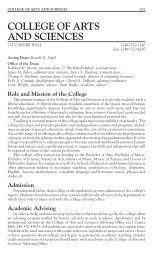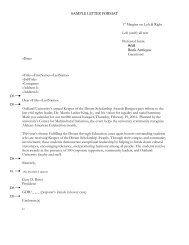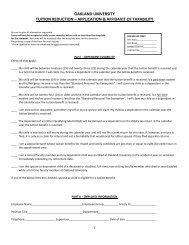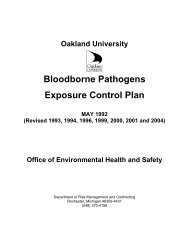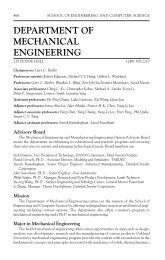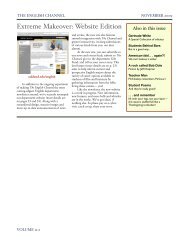MOM 2006 journal for pdf.pmd - University of Michigan-Flint
MOM 2006 journal for pdf.pmd - University of Michigan-Flint
MOM 2006 journal for pdf.pmd - University of Michigan-Flint
You also want an ePaper? Increase the reach of your titles
YUMPU automatically turns print PDFs into web optimized ePapers that Google loves.
While many state that this ruling is a victory <strong>for</strong> consumers, it contains many glaring glitches that<br />
most Americans may not fully understand. In an attempt to make the American food supply safer,<br />
the FDA has created a false sense <strong>of</strong> security in regards to trans fats. This open trap contains three<br />
loopholes that, if not properly addressed, could continue to wreak financial havoc <strong>for</strong> our nation’s<br />
healthcare system. The first is that trans fats will not have a percentage daily value associated with<br />
their prevalence in the product itself. The Nutrition Policy Director at the Center <strong>for</strong> Science in the<br />
Public Interest, Margo Wootan, confirms that “The new labels will let consumers compare trans fat<br />
content from product to product and that will be a great step <strong>for</strong>ward. It will be hard, though, <strong>for</strong><br />
people to tell if a given number <strong>of</strong> grams <strong>of</strong> trans fat is a lot or a little. Five grams may not seem like<br />
a lot, but it is” (qtd. in Corcoran). This is an inherent problem in the United States, which does not<br />
widely use the metric system, yet uses that same system to measure the ingredients you put into your<br />
body. Without the percentage daily value, the number <strong>of</strong> grams given is almost as useless as the<br />
trans fats they measure. In addition, Pat Martin, a Democrat <strong>for</strong> the Winnipeg Centre in Canada,<br />
addressed this labeling error in his 2004 speech to Parliament. He stated that “there is the added<br />
problem that even if a product does say it contains 3.6 grams <strong>of</strong> partially hydrogenated oil, there are<br />
no editorial comments allowed on the label because the only really valuable label in terms <strong>of</strong> trans<br />
fats would be, ‘This product contains trans fats. Do not eat it because it will kill you.’ We are not<br />
likely to see that type <strong>of</strong> labeling introduced.” Martin also stated that 70% <strong>of</strong> consumers never read<br />
labels anyway. He suggests that labeling is not the way to reach unin<strong>for</strong>med consumers.<br />
The second error <strong>of</strong> the labeling law is that it doesn’t even apply to restaurants. This is very<br />
serious because adults consume about 38% <strong>of</strong> their total fat intake from restaurants (Jacobson 2). In<br />
addition, children eat 40% <strong>of</strong> their meals in fast food restaurants (Severson). With more and more<br />
Americans not cooking what they put in their own mouths, the Dietary Guidelines Advisory<br />
Committee (DGAC) strongly advised in 2004 that people should consume 1 percent or less, or less<br />
than 2 grams <strong>of</strong> their calories from trans fat daily. However, this task is virtually impossible. Even<br />
just one small bag <strong>of</strong> McDonald’s fries cooked in partially hydrogenated oils has 3.4 grams <strong>of</strong> trans<br />
fat, about a day- and-a-half’s worth <strong>of</strong> trans fats (Cronin). The New England Journal <strong>of</strong> Medicine<br />
also concluded that<br />
[Labels] are not enough. Many fast foods contain high levels <strong>of</strong> trans fatty<br />
acids, are exempt from labeling regulations, and can even be advertised as<br />
cholesterol-free and cooked in vegetable oil. For example, the<br />
consumption <strong>of</strong> one doughnut at breakfast (3.2 g <strong>of</strong> trans fatty acids) and a<br />
large order <strong>of</strong> French fries at lunch (6.8 g <strong>of</strong> trans fatty acids) adds 10 g <strong>of</strong><br />
trans fatty acids to one’s diet and represents 5 percent <strong>of</strong> the total energy<br />
intake on an 1800-calorie diet, and neither product needs to be labeled<br />
(Ascherio, Stampfer, Willett).<br />
Clearly the exemption <strong>of</strong> restaurants from the labeling law is more than just a technicality; it<br />
undercuts the entire purpose <strong>of</strong> the labeling law on a major scale.<br />
Perhaps the most serious lapse in the trans fat labeling issue is the deception raised by Eric<br />
Armstrong in his online posting. The trans fats labels will only indicate the amount <strong>of</strong> trans fats<br />
Meeting <strong>of</strong> Minds <strong>2006</strong> 24



